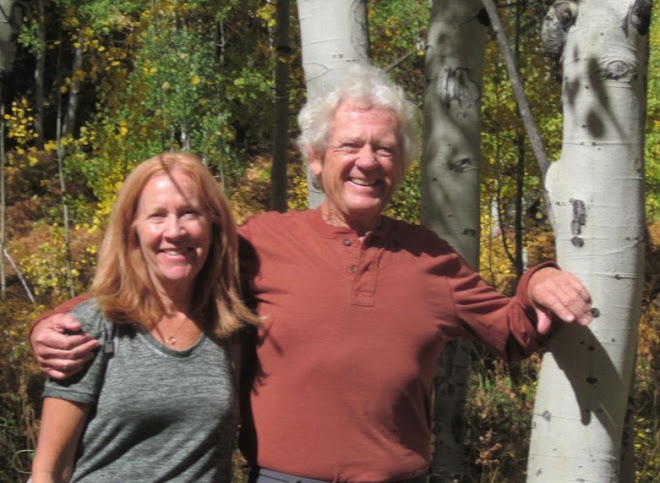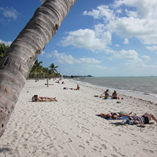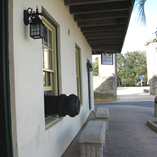Pat and Ron's Travel Adventures

Welcome
Happy Trails!
Tuesday, January 29, 2013
A Subtropical Paradise
Key West (KW) claims to be the only city in the lower 48 states never to have had a frost. Prevailing easterly trade winds and sea breezes suppress the usual summertime heating and 100 degrees is never seen. They have a wet season (May-Oct) and a dry season (Nov-Apr.) Rain falls on most days of the wet season. Early morning is the favored time for these showers, which is different from mainland Florida, where showers and thunderstorms usually occur in the afternoon. Houses have lush landscaping (for cooling), full wrap-around porches (for ventilation), and many windows with usable shutters. Metal roofs were once used to collect drinking water are now mandatory to prevent spread of fire from house to house.
When the Spanish came to KW, they saw the island littered with the bones, so they named it bone island, “Cayo Hueso”. Key West is a false-friend Anglicization (i.e. converted to something sounding familiar) of Cayo Hueso. The reason for all the bones will never be known - was it a communal graveyard, a battleground, a prison, or the site of a major catastrophe?
The island is only 4 miles by 1.5 miles. There are more than 800 Florida Keys. But KW is located strategically in-between the ocean and the gulf and has a deep water channel, so it had value to sailors and fishermen. John Simonton bought the island for $2000 from the Spaniard Juan Pablo Salas in 1821. KW is the southernmost city in the continental US. It is closer to Havana, Cuba (90 miles away) than to Miami (157 miles.) Its latitude [24 deg North; near the Tropic of Cancer] is the same as Mazatlan, Taiwan, and way south of Cairo, Egypt. The island was settled by Cubans and Bahamans. There is a large Cuban influence here as many immigrated here during the unsuccessful Cuban war for independence in 1860-70. In 1890, half the residents here were Cuban.
KW was very isolated from mainland US until Henry Flagler completed the train “Flagler’s Folly” all the way to KW in 1912. This accessibility increased shipping to where KW became the largest shipping port in the US at that time. The train track was trashed by a hurricane on Labor Day 1935, the tracks abandoned, so the State of FL eventually took it over and used the train trestles to build the current road. There are 42 bridges on these Keys, going 100 miles from Key Largo to Key West. The road was completed in 1938 and is called the Overseas Hwy and was added to US1 which ends in Maine. Mile Marker 0 is downtown KW. The US Navy and Coast Guard have always had a strong presence here. Because of this, in the Civil War, KW was a northern held area within a seceded state.
In 1982, there was a US border guard patrol set up in Florida City (on mainland Florida off the Keys) looking for illegal immigrants. Stopping every car coming from the Keys resulted in a 17 mile gridlock greatly impeding the tourist industry. The mayor of KW thought that if KW was being treated like a foreign country, it may as well secede. So it did and called itself the Conch Republic. Following the script of a 1950’s movie- “The Mouse That Roared,” the Mayor went on to declare war on the US, then KW immediately surrendered and applied for billions in foreign aid. Naturally it was disregarded, but they got lots of press, public sympathy, and the border guard removed. A native KW resident is called a “Conch” and the Conch Republic flag still flies.
The shore is protected by the largest and only living coral reef in the US, the “Florida Reef”. The reef is 4 miles wide, 170 miles long, stretching from Stuart FL to the Dry Tortugas. This is the 3rd longest living reef in the world. As a result there were many shipwrecks off the coast and there are no large waves. So surfing is not good here and there are only a few beaches, whose sand has been brought in from the Bahamas.
The major original industries here were (1) wrecking (2) sponges and (3) Cuban cigars. Fishing and hunting turtles were also going on. Due to the coral reef, there were 4 wrecks a week. When a wreck occurred, sea captains raced to save lives and to claim the salvage cargo. The wrecking industry made KW the richest city in the US ~1850. Most people had chinaware that didn’t match; silverware with various initials; and front doors used as gates even today. All thanks to salvage sales. The sponge industry was large here, but wiped out by red tide, and now replaced by synthetic sponges. Now natural sponges are protected. Cuban cigars were once hand-rolled in 100 factories during the peak of the industry. The fire of 1886 wiped out all cigar warehouses except one since it was made from brick. Most relocated to Ybor City in Tampa. Pan American Airlines was founded 1926 in KW, mostly to fly people to Cuba. Unsurprisingly, the only real industry now is tourism.
KW, being a marine and wildlife preserve, protects sponges as well as the roosters that are everywhere. They are leftovers from fighting roosters brought here from Cuba and are really out of control, much like on Kauai. Iguanas are also plentiful, not indigenous, and eat flowers which affect the hummingbird population as well as other small birds. Descendants of Hemingway’s polydactyl (six-toed) cat “Snowball” are still here and roaming around.
KW is supposedly the 3rd most haunted city – after New Orleans and Savannah. We kept a lookout for ghosts and ghost ships, but then, we always do! We walked the floors of the La Concha hotel, but alas, saw none of the 13 resident ghosts. The cemetery here is similar to New Orleans style too, since the highest elevation on the island is 18 feet, it doesn’t take much of a storm to wipe out a cemetery or to pop out a buried coffin (yew). So the cemetery was moved to slightly higher ground and most burials are now in above-ground concrete or granite chambers.
The tourist attractions include the Little White House (President Truman came here 11 times), the Hemmingway House (where Ernest lived, wrote, and drank), and Tennessee Williams’ (“Streetcar Named Desire”) house. Naturally the famous Duval Street is the #1 place where tourists roam. It has 66 bars, including Sloppy Joe’s, Hog’s Breath, and the Bull and Whistle (with its clothing optional roof bar called “The Garden of Eden.”) Some visitors and locals have taken a challenge to do the “Duval Crawl” and visit all of them. There are tons of restaurants & shops, and, of course, the original Margaritaville store and restaurant featuring “Cheeseburgers in Paradise.” Mallory Square is also a gathering spot at sunset and is a perfect place to watch sunsets, street performers, and schooners sailing out. Fantasy Fest is KW’s Mardi Gras type of celebration. It is held at the end of October to celebrate the end of the hurricane season. Fantasy Fest regularly attracts approximately 80,000 people to the island and has become a huge success. All year long there are many festivals and races here as in most all tourist towns. While we were here there was a half marathon, an ironman triathlon, a 150-mile relay race from Miami, and a seafood festival. We had several sets of visitors with whom we were able to share this paradise and a rum drink or two, or three.
While thoroughly enjoying ourselves in this Paradise, after 4 weeks, we started looking forward to moving on to our next adventure and saying good bye to KW. Was it a bit of “Island Fever” or our “itchy feet” that provided the motivation? Who knows? But we do know that we have embraced our wanderlust lifestyle and always look forward to our next adventure with anticipation.
Until then, let’s hear from you, and Happy Trails.
Tuesday, January 1, 2013
December in Florida
From the Georgia border of Cumberland Island and Saint Marys, we finally reached our southernmost winter destination. It only took us 6 months, but, as you know by now, we never take the shortest, most direct route. Spending the remainder of December in Florida turned out to be ideal, since sunny Florida was one of the few states not to have snow and cold this month.
This pleasant, balmy weather was perfect for outdoor activities as bicycling (around towns and on beaches); kayaking in rivers and lakes; long walks on beaches, islands, and on live-oak covered paths; taking in sunrises on the Atlantic side and sunsets on the Gulf side; bird watching (eagles, wood storks, herons, cormorants, egrets); manatee seeking; searching for other wildlife (alligators, turtles, snakes); eating local fish; and checking out Christmas decorations.
Florida does an exceptional job of decorating for Christmas. It did take some getting used to Santa wearing shorts, on a surfboard pulled by dolphins. We went to the Candlelight Processional at Epcot and Disney never fails to come through. This is by far the best Christmas Carol show we have ever attended. Trace Atkins was the narrator who told the story of the Christ child, and in his deep resonant voice, he sounded like God himself. There were Christmas decorations at all of the 11 countries showcased there. Further south, we spent Christmas with Ron’s sister & her husband, so we were blessed to share the warmth of the holiday with family.
The time between Christmas and New Year’s in Florida is alive with energy and activity. The winter visitors started arriving, families were vacationing during the holidays, and many foreign visitors were enjoying the national parks, warm weather, and beaches, just as we were.
After a short stay near the Everglades and Key Biscayne National Parks, we are now heading for Key West to begin the New Year. Here is wishing all of you the happiest, healthiest 2013.































